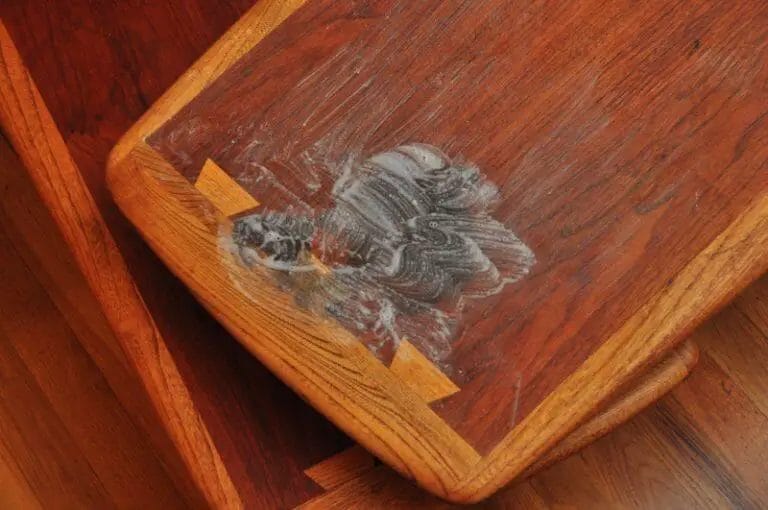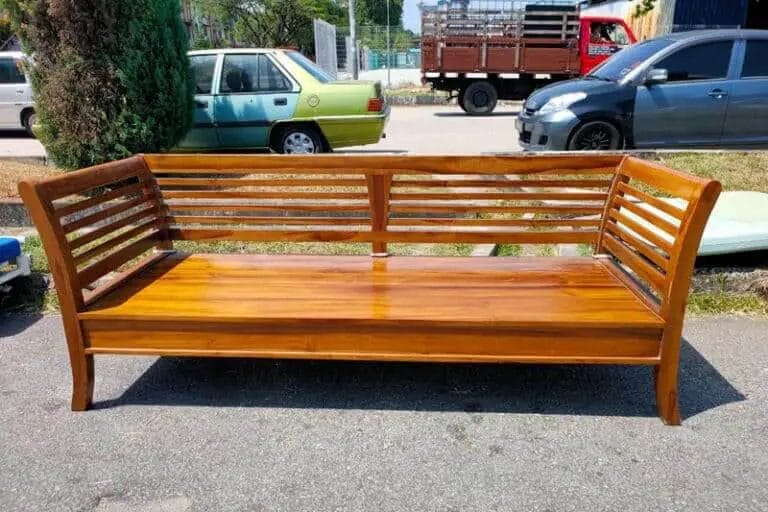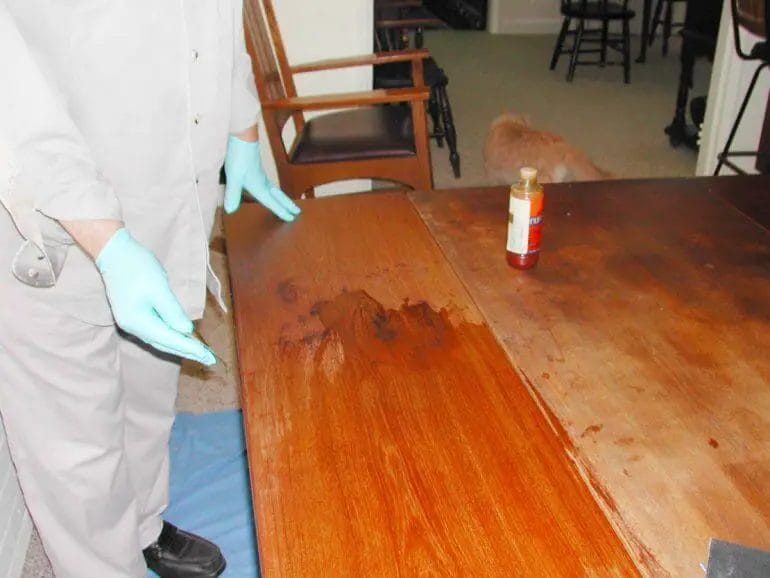Teak wood is naturally resistant to water and can withstand exposure to moisture without deteriorating. Its high content of natural oils and silica makes it highly resistant to rot, decay, and warping caused by water absorption.
This unique characteristic of teak wood makes it an ideal choice for outdoor furniture, boat decks, and other applications that are exposed to the elements.

However, while teak wood can withstand occasional wetting, it is still recommended to provide proper maintenance and care, such as regular cleaning and oiling, to prolong its lifespan and enhance its water resistance.

The Effects of Water on Teak Wood and How to Prevent Them
Teak wood is a popular choice for outdoor furniture and decking due to its durability and natural beauty. However, like any other wood, teak is susceptible to damage from water. In this section, we will explore the effects of water on teak wood and provide some tips on how to prevent them.
1. Warping
One of the most common effects of water on teak wood is warping. When exposed to moisture, teak wood can absorb water, causing it to expand and contract. This can lead to the warping of the wood, making it uneven and unsightly. Warping can also compromise the structural integrity of teak furniture and decking.
To prevent warping, it is important to protect teak wood from direct contact with water. Applying a high-quality sealant or finish to the wood can create a protective barrier and prevent water from seeping in. Regular maintenance, such as cleaning and oiling, can also help keep the wood in good condition.
2. Discoloration
Another effect of water on teak wood is discoloration. When exposed to moisture and sunlight, teak wood can develop a gray or silver patina over time. While some people appreciate this natural weathered look, others prefer to maintain the original golden color of teak. Discoloration can also occur in the form of water stains or mold and mildew growth.
To prevent discoloration, it is recommended to regularly clean and treat teak wood with a teak cleaner and brightener. These products can help remove dirt, stains, and mold, restoring the wood to its original color. Additionally, keeping teak furniture and decking dry by wiping off any water or spills can help prevent discoloration.
3. Rotting
Water can also cause teak wood to rot over time. When exposed to excessive moisture, teak wood can start to decay, leading to weakened and damaged furniture or decking. Rotting is more likely to occur in areas where water accumulates, such as around the base of furniture or in the gaps between decking boards.
To prevent rotting, it is important to ensure proper drainage for teak furniture and decking. Elevating the furniture off the ground or using cushions that allow air circulation can help prevent water accumulation. Regularly inspecting and repairing any damaged or rotted areas can also help prolong the lifespan of teak wood.
4. Cracking and Splitting
Exposure to water can cause teak wood to crack and split. When water penetrates the wood fibers, it can lead to the expansion and contraction of the wood, causing stress and eventually resulting in cracks and splits. This can significantly affect the appearance and functionality of teak furniture and decking.
To prevent cracking and splitting, it is important to protect teak wood from excessive moisture. Avoid placing teak furniture in areas where it is directly exposed to rain or sprinklers. Applying a protective sealant or finish to the wood can also help minimize water absorption and reduce the risk of cracking and splitting.
In summary, water can have detrimental effects on teak wood, including warping, discoloration, rotting, cracking, and splitting. To prevent these effects, it is important to protect teak wood from direct contact with water, regularly maintain and clean the wood, and ensure proper drainage. By taking these preventive measures, you can maintain the beauty and durability of your teak furniture and decking for years to come.

Waterproofing Techniques for Teak Wood Furniture
Teak wood furniture is known for its durability, beauty, and resistance to outdoor elements. However, even teak wood furniture can benefit from additional protection against water damage. In this section, we will explore different waterproofing techniques that can help prolong the lifespan and maintain the appearance of your teak wood furniture.
1. Teak Oil
One of the most popular methods of waterproofing teak wood furniture is by using teak oil. Teak oil is specifically formulated to penetrate deep into the wood, providing protection against moisture. It enhances the natural color of teak wood and helps maintain its rich appearance.
To apply teak oil, start by cleaning the furniture with a mild soap and water solution. Once the furniture is dry, use a brush or cloth to evenly apply the teak oil in the direction of the wood grain. Allow the oil to soak into the wood for about 15 minutes, then wipe off any excess oil with a clean cloth. Repeat this process every few months or as needed to maintain the water-resistant properties of the wood.
2. Teak Sealers
Another effective way to waterproof teak wood furniture is by using teak sealers. These sealers create a protective barrier on the surface of the wood, preventing water from seeping in. They also help to preserve the natural color of the teak wood.
Prior to applying a teak sealer, ensure that the furniture is clean and dry. Follow the instructions provided by the manufacturer for the specific sealer you are using. Generally, you can apply the sealer using a brush or cloth, making sure to cover the entire surface evenly. Allow the sealer to dry completely before using or exposing the furniture to water.
3. Varnish or Polyurethane
For a more durable and long-lasting waterproofing solution, you can consider using varnish or polyurethane on your teak wood furniture. These coatings provide an additional layer of protection against water damage and can help maintain the beauty of the wood for years to come.
Before applying varnish or polyurethane, it is essential to sand the furniture’s surface to ensure a smooth finish. Follow the instructions provided by the manufacturer for the specific product you are using. Apply the varnish or polyurethane evenly in thin coats, allowing each coat to dry completely before applying the next. Sand lightly between coats for a smooth and even finish.
4. Covering and Maintenance
Aside from using waterproofing techniques, covering your teak wood furniture when not in use can also help protect it from water damage. Use a waterproof cover or store the furniture indoors during periods of heavy rain or snow. This simple step can significantly extend the lifespan of your furniture.
In summary, waterproofing your teak wood furniture is essential to maintain its longevity and appearance. Whether you choose to use teak oil, sealers, varnish, or polyurethane, these techniques can provide the necessary protection against water damage. Additionally, covering your furniture when not in use and practicing regular maintenance will further enhance its durability. By implementing these waterproofing techniques, you can enjoy your teak wood furniture for many years to come.

Understanding Teak Wood’s Water Resistance Properties
Teak wood is widely regarded as one of the most durable and water-resistant woods available in the market. Its natural properties make it suitable for various applications, including outdoor furniture, shipbuilding, and flooring. In this section, we will delve into the reasons behind teak wood’s exceptional water resistance and explore its benefits.
1. Natural Oils
One of the primary reasons for teak wood’s water resistance is its natural oil content. Teak wood contains an abundance of natural oils that act as a protective barrier against moisture. These oils penetrate deep into the wood, making it highly resistant to water damage such as warping, cracking, or rotting.
The natural oils present in teak wood also help repel water. When exposed to rain or other forms of moisture, the oils form a layer on the wood’s surface, preventing water from seeping into the grain. This characteristic makes teak wood an excellent choice for outdoor furniture that is constantly exposed to the elements.
2. High Density
Teak wood is known for its high density, which plays a significant role in its water resistance properties. The dense nature of teak wood makes it less porous, reducing the likelihood of water absorption. This, in turn, prevents the wood from swelling or warping when exposed to moisture.
The high density of teak wood also contributes to its overall durability. The dense structure makes it less prone to damage caused by water, insects, or fungi, ensuring its longevity even in damp conditions.
3. Natural Rubber Content
In addition to its natural oil content and high density, teak wood also contains a substance called natural rubber. This rubber content further enhances the wood’s water resistance properties. Rubber is inherently waterproof, providing an additional layer of protection to the wood.
The presence of natural rubber in teak wood also contributes to its flexibility and resistance to cracking. This makes teak wood an ideal choice for applications where frequent exposure to moisture is expected.
4. Maintenance and Care
While teak wood is inherently water-resistant, proper maintenance and care can further enhance its longevity and water resistance. Regular cleaning, oiling, and sealing can help maintain the wood’s natural oils and protect it from harsh environmental conditions.
It is important to note that teak wood’s water resistance properties do not make it completely impervious to water damage. Over time, exposure to extreme weather conditions or prolonged contact with water can still cause some degree of wear and tear. However, compared to other types of wood, teak wood stands as a reliable option with excellent water resistance capabilities.
In summary, teak wood’s exceptional water resistance properties can be attributed to its natural oil content, high density, and the presence of natural rubber. These factors make teak wood highly resistant to water damage, warping, and rotting. By properly maintaining and caring for teak wood, its water resistance can be further enhanced, ensuring its longevity and durability. Whether used for outdoor furniture, shipbuilding, or flooring, teak wood is a reliable choice for water-resistant applications.
Tips for Caring and Maintaining Teak Wood in Wet Environments
Teak wood is known for its durability, natural beauty, and resistance to water. It is a popular choice for outdoor furniture, boat decks, and other applications that are exposed to wet environments. However, even though teak wood is naturally resistant to water, it still requires proper care and maintenance to ensure its longevity and keep it looking its best. In this section, we will provide you with some useful tips to care for and maintain teak wood in wet environments.
1. Clean Regularly
One of the most important steps in caring for teak wood in wet environments is regular cleaning. Use a mild soap or teak wood cleaner to remove dirt, grime, and algae buildup. Avoid using harsh chemicals or abrasive cleaners as they can damage the wood’s natural oils and finish. Gently scrub the surface with a soft brush or sponge and rinse thoroughly with water.
2. Prevent Mold and Mildew
To prevent the growth of mold and mildew on your teak wood furniture or surfaces, it is essential to keep them dry and well-ventilated. After cleaning, make sure to dry the wood thoroughly using a clean cloth or allow it to air dry completely before covering or storing. Avoid placing items directly on the teak wood surface that can trap moisture and create a breeding ground for mold and mildew.
3. Apply Teak Oil or Sealant
Teak wood naturally contains oils that help protect it from water damage. However, over time and exposure to the elements, these oils can dry out, causing the wood to lose its natural luster. To maintain the wood’s appearance and provide additional protection, you can apply teak oil or a sealant specifically designed for teak wood. Follow the manufacturer’s instructions and reapply as needed to keep the wood moisturized and protected.
4. Use Protective Covers
When teak wood furniture or surfaces are not in use, it is advisable to cover them with protective covers. This will shield them from direct exposure to rain, snow, and other elements that can cause water damage. Choose covers made from breathable materials to prevent moisture buildup and allow for proper air circulation.
5. Avoid Direct Sunlight
While teak wood is resistant to water, prolonged exposure to direct sunlight can cause it to fade and lose its natural color. To prevent this, place teak wood furniture or surfaces in shaded areas or use umbrellas or awnings to provide shade. If direct sunlight is unavoidable, consider using a UV-protective sealant to minimize sun damage.
6. Sand and Refinish
Over time, teak wood may develop small cracks or surface imperfections due to weathering. To restore its smooth and polished appearance, you can sand the surface with fine-grit sandpaper and then apply a new coat of teak oil or sealant. This process will not only repair any damage but also rejuvenate the wood and enhance its natural beauty.
7. Regular Inspections
Lastly, it is crucial to regularly inspect your teak wood furniture or surfaces for any signs of damage or wear. Look for cracks, splits, or discoloration, and address them promptly to prevent further deterioration. By catching and addressing issues early on, you can prolong the lifespan of your teak wood and maintain its pristine condition in wet environments.
In summary, teak wood can withstand wet environments but requires proper care and maintenance to ensure its longevity and appearance. Regular cleaning, prevention of mold and mildew, application of teak oil or sealant, use of protective covers, avoidance of direct sunlight, sanding and refinishing when necessary, and regular inspections are essential steps in caring for and maintaining teak wood in wet environments. By following these tips, you can enjoy the beauty and durability of teak wood for years to come.
FAQs
Can teak wood get wet?
Yes, teak wood can get wet. However, teak wood is naturally resistant to water and has a high oil content, which helps protect it from moisture damage. It is commonly used for outdoor furniture and boat decks because of its ability to withstand exposure to water.
Conclusion
In conclusion, teak wood is highly resistant to water and can withstand exposure to moisture without any adverse effects. Its natural oils and dense grain structure make it impervious to water penetration, preventing warping, rotting, or decay. Whether used for outdoor furniture, boat decking, or bathroom fixtures, teak wood proves its durability and longevity in wet environments.
Furthermore, its resistance to water also makes teak wood an excellent choice for humid climates, as it does not absorb moisture and swell like other types of wood. This characteristic ensures that teak furniture and structures maintain their shape and integrity over time. So, if you are looking for a wood that can withstand wet conditions and maintain its quality, teak wood is undoubtedly the ideal choice.